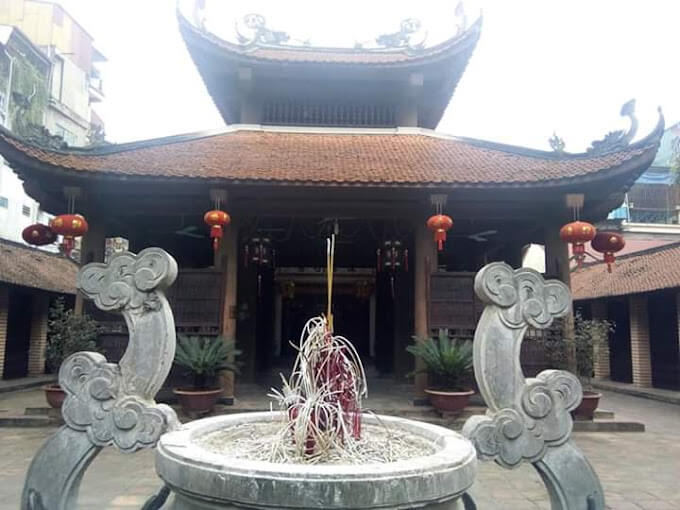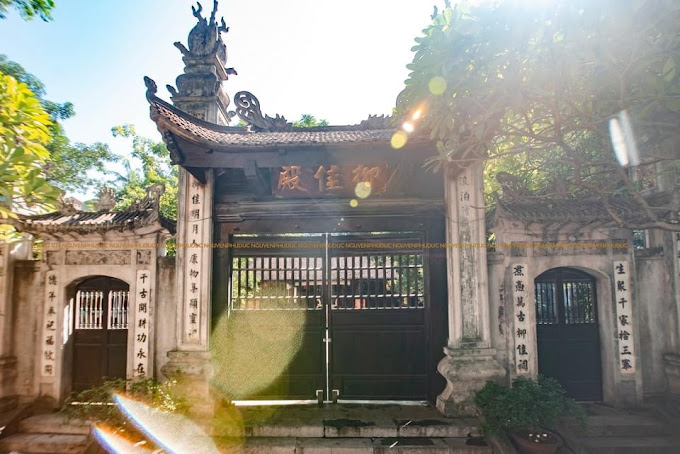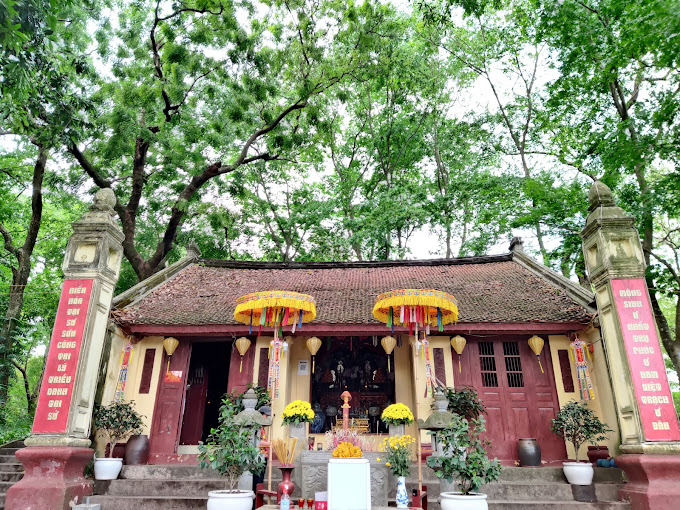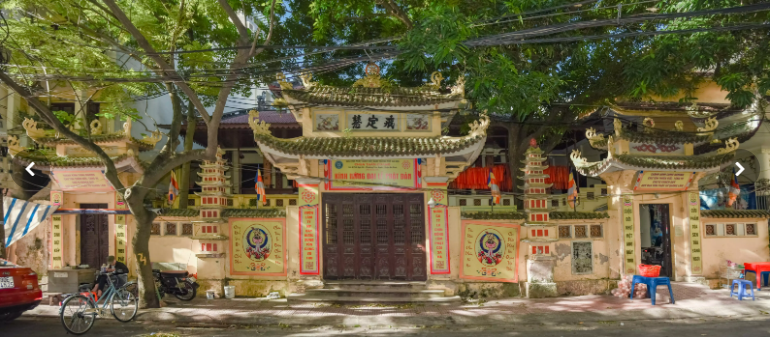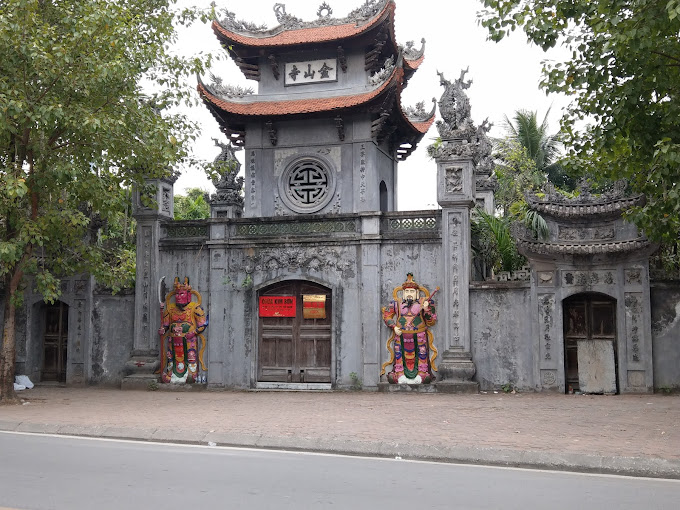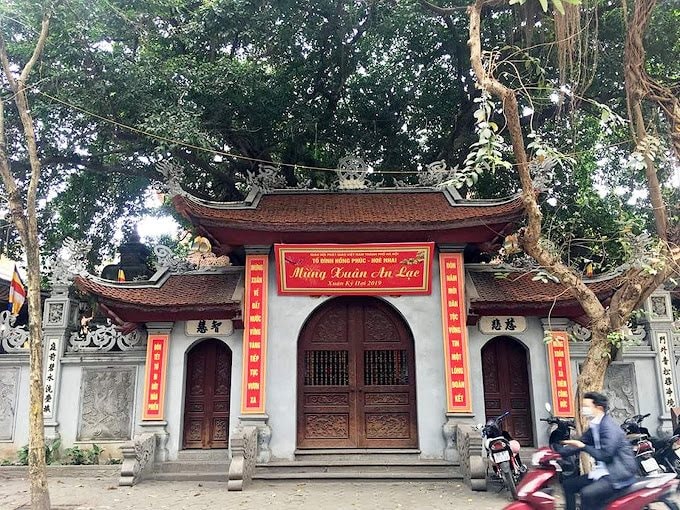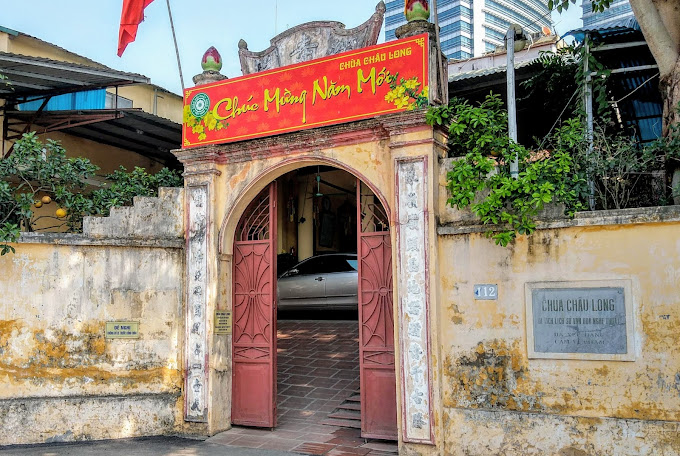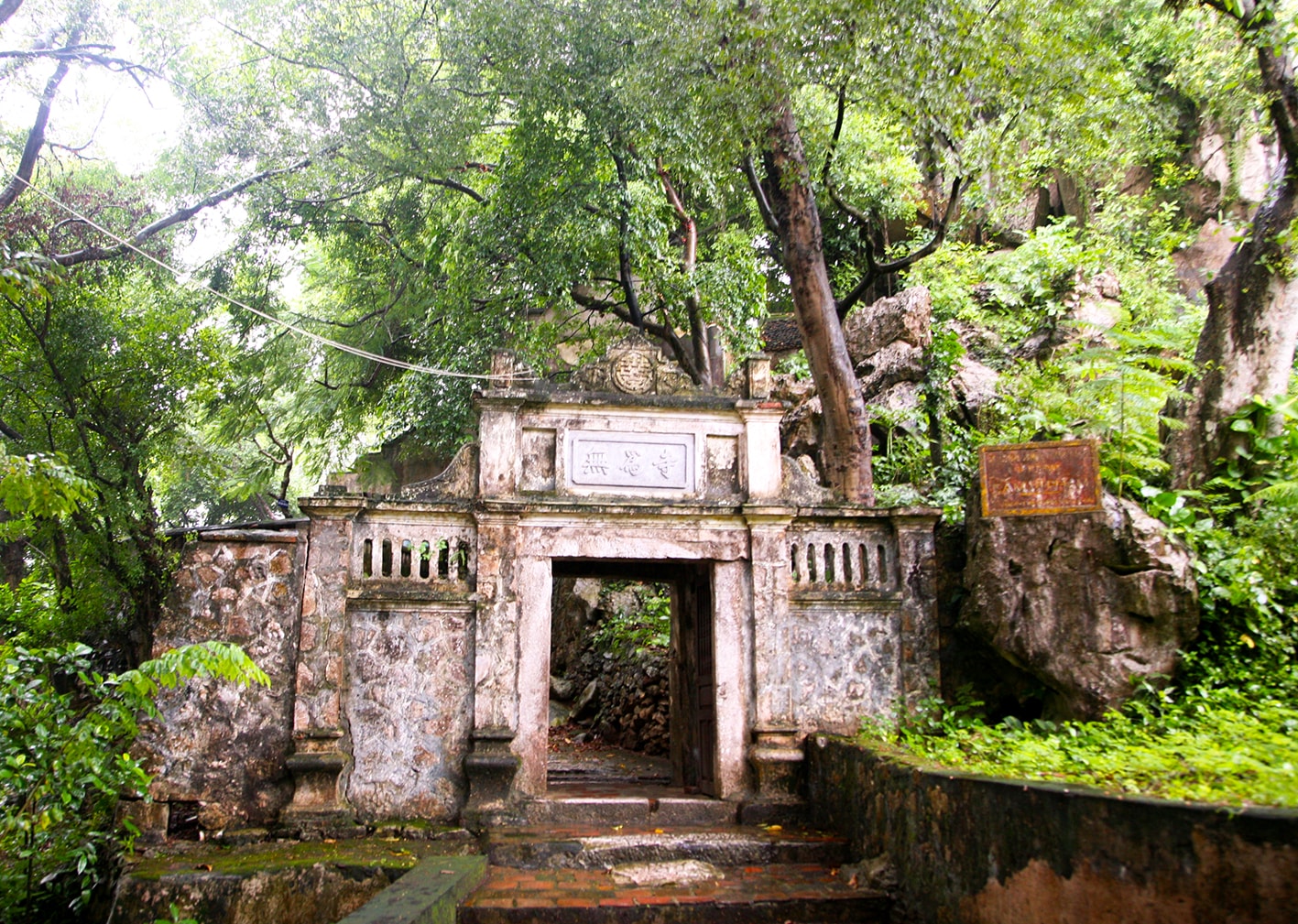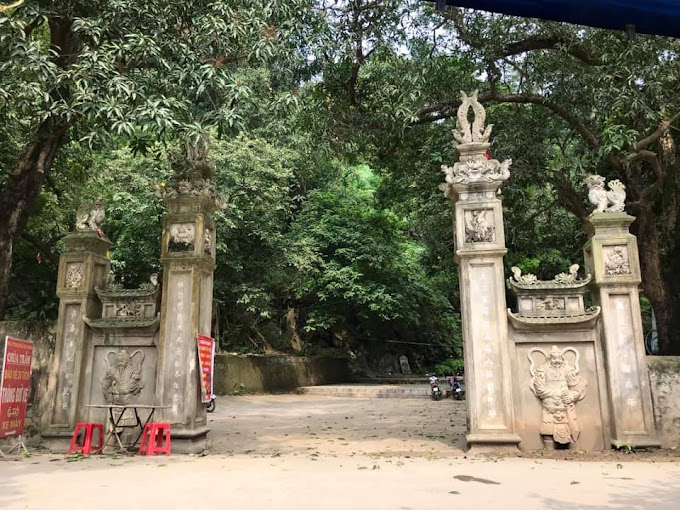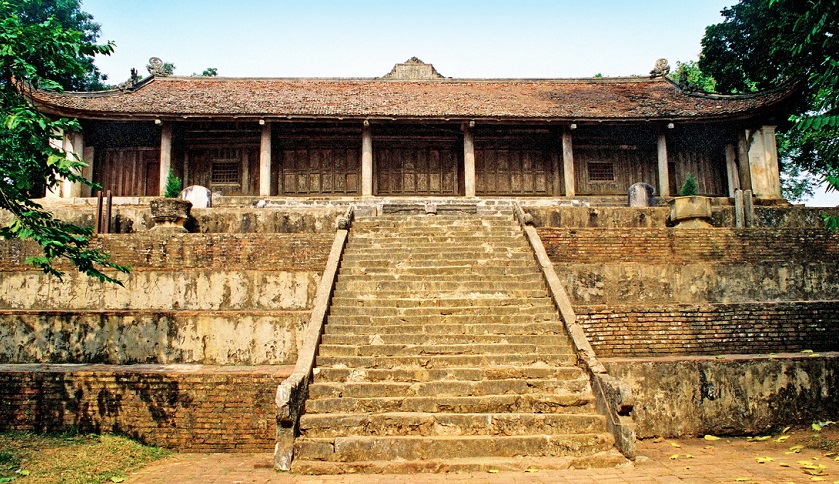Relic point Vietnam
Việt NamGiang Vo Communal House
Giang Vo communal house worships Mrs. Ly Thi Chau Nuong. According to the family tree kept in Dinh, she was from Vo Trai (Giang Vo). At the age of 16, she was proficient in martial arts and had perfect intelligence and courage. Her husband is General Tran Thai Bao - Director of Chau Hoan Department (now Nghe An province). During the third fight against the Mongol invaders, surrounded by the enemy, he led his troops to break through the siege. She disguised herself as a man and commanded the soldiers to defend the citadel and protect the treasure for more than a month. After that, mandarin Thai Bao recruited more soldiers and headed to the citadel to relieve the siege. She joined the army to fight, the Yuan army lost and had to retreat. King Tran Nhan Tong heard the news and praised Chau Nuong's intelligence and appointed her the title Princess Treasurer of the Great Lady. After that victory, he was promoted to the title of Commander Duc Thanh, commanding the army to protect the king and Thang Long capital. She had full authority to collect military salaries from the National Treasury and manage Phung Thien palace. In a fierce battle, she heroically sacrificed her life in 1287. King Tran awarded her the title "Heroic Spirit Responding to the Treasurer, Princess of the Great King's Treasurer, Lady Thanh Mau" and ordered Giang Vo village to build a temple. Grandma. To show respect to the heroic daughter, she was worshiped as the Tutelary God of Giang Vo village, so the Temple to worship her was called the Communal House, and the people used to call it the Temple of Lady Kho (besides Giang Vo, which is the main place of worship). According to the King's orders, many villages in Chau Hoan also established Temples to worship her. Her communal house is located in the middle of the old Giang Vo village (now Lane 612, La Thanh Street, Giang Vo Ward, Ba Dinh District, Hanoi), located on a land area of nearly 2,000 m2. Although destroyed by war and time, restored and rebuilt, the communal house still retains its beautiful and ancient architecture. In front is a shrine to Miss De Nhat and Miss De Nhi, two of her servants. In the middle is Phuong Dinh house, inside is the Dai Dinh building, where the Tablet and Dragon Throne are worshiped. The oldest relics of the communal house are the Ta Mac and Huu Mac houses located on both sides of Phuong Dinh house. This is a house with unique ancient architecture, hitch truss structure, gable end with pillars supporting the roof. At the top of the pillar are two cows facing each other. In addition, in the communal house grounds there are also 4 stone pigs, 2 stone steles and some stone pillars previously used to support the pillars of the communal house. On the roof of the communal house, there is a large inscription with four words "Ly Tran Phuong Danh" (the name of the Ly Tran family). In the communal house, there is a large inscription "Nu Trung Anh Hero" (a heroic hero among women) and a couple of sentences praising her: Finances are sufficient for the army, and the internal destiny is written according to the Emperor's decree. Conspiracy or retreat, the country's reputation will shake the goddess. Pandemic : The wealth was enough to support the army, and everywhere heard the news of the King's passing. Always planning to defeat enemies, the country is famous for its talented women. In front of the communal house's yard are ancient banyan trees reflecting on the clear blue water, enhancing the majesty and ancient look of the communal house. On July 20, 1994, Giang Vo Communal House was recognized as a National Historical Site. Giang Vo communal house worships Ba Chua Kho, a sacred communal house of Hanoi. Every year, the Communal House organizes a traditional festival on her birthday (February 12 of the lunar calendar) and death day (July 20 of the lunar calendar). In addition, on the 23rd day of the 12th lunar month, the Vietnam Exhibition Fair Center, Giang Vo Ward People's Committee and the Central Tuong Theater jointly organize a procession of her tablet and incense bowl to pray for peace in the country and people. The festival is held solemnly, imbued with national identity, free from superstition, attracting a large number of people in the region and visitors from all over. Source: Electronic information portal of Ba Dinh district, Hanoi city.
Hanoi 3312 view
Communal House - Lieu Giai Temple
Lieu Giai Communal House - Temple Historical Relic Area is located in Lieu Giai ward, Ba Dinh district. Temple of Thanh Mau and Princess Ngoc Nuong. According to legends preserved at the temple, in Phan Son village, Bang Chau district, Nam Sach district, Hai Duong province, there is a family whose last name is Ly, whose name is Nghi, whose wife's name is Hoang, with a cultural tradition that has had members for three or four generations. be an official. Ly Nghi worked as an official of the Ministry of Rites during the reign of King Tran Nhan Tong. One hot day, she went to Bach Nhan lake to bathe. Suddenly, a white snake appeared and swam towards her and wrapped itself tightly around her. The following year, at the Dragon hour on March 21, Giap Thin, she gave birth to a baby girl, named Ngoc Nuong. The older she became, the more beautiful she became, more gentle and intelligent than others. At the age of 18, Ngoc Nuong went on a boat to watch the moon on the night of the 17th day of the 8th lunar month. When she arrived at Lieu Giai camp, she encountered a thunderstorm. At that time, a snake about 10 meters long appeared to take Ngoc Nuong back to the Water Kingdom. My parents were extremely compassionate and built a temple to worship Ngoc Nuong on the land next to Bach Nhan Lake, later called Dong Nuoc Lake. During Tran Anh Tong's reign, the Mongol invaders invaded our country. Ngoc Nuong plotted to help the king defeat the enemy in a major battle. The king then gave the villagers 100 mandarins to repair the temple and ordained the female scholar: "Eternal blood and food, Du Quoc Dong has not written, Female white tiger, Thuy Tinh Ton Linh princess, Ho second brother one death". During the dynasties of kings Vinh Khanh, Canh Hung, Chieu Thong, Minh Minh, Thieu Tri, Tu Duc, Duy Tan, and Khai Dinh, they all had the title: Thuy Tinh Princess of Superior Court. Lieu Giai Temple faces southwest. After many renovations, it now has the architectural art style of the Nguyen Dynasty. The temple is built in the shape of the letter "Cong", with Co pavilion, Cau pavilion, in the middle is the Thanh Mau temple, on the right side is the Mau Cuu Trung Thien pavilion. During the anti-French period in 1946, the colonialists suspected there were hidden revolutionary soldiers, so they fired mortars, causing destruction. The festival celebrates the transformation day of the Holy Mother Ngoc Nuong on the 17th day of the 8th lunar month, January 12th is the festival commemorating the transformation day of tutelary god Hoang Phuc Trung. Lieu Giai Temple - Communal House was decided by the Ministry of Culture and Information to recognize and rank as a national historical, artistic and architectural relic on December 27, 1990. Source: Electronic information portal of Ba Dinh district, Hanoi city.
Hanoi 3156 view
Mount Sua Temple
Mount Sua Temple is located on top of Mount Sua in the western area of Thang Long citadel of Thap Tam Trai land, now in Bach Thao Park, Ngoc Ha ward, Ba Dinh district. The temple worships Huyen Thien Hac De - the god who assisted Ly Thanh Tong in fighting the Champa invaders, fighting against foreign invaders, and protecting the independence and autonomy of the nation. The temple was built in the 19th century. According to the legend of Huu Tiep village, before the Ly dynasty, in Sua mountain area, Quang Duc district, Phung Thien district of Thang Long citadel, there was a famous chief named Ly Phuc, married to Hoang Thi Duc from the area. The couple has a rich family background, is tolerant in nature, cultivates virtue, and often takes care of the poor and destitute. There's nothing I don't try to do when it comes to helping people. The only thing is that the couple was three weeks pregnant and still had no children, so they immediately went to the One Pillar Pagoda to pray day and night with incense lamps without end. One day, in the dark temple, suddenly I saw a halo of light shining brightly in one corner, shaped like a torch. The couple dreamed of a white-haired and bearded mandarin holding a baby boy and giving it to his grandparents, saying that this child was the third child of the Jade Emperor, and because he was guilty of breaking the jade cup in heaven, he had to be born. earthly. Now seeing that the couple's family is blessed, Hoang Thien has decided to reincarnate as your child. Saying this, the couple hugged the baby and saw the mandarin fly into the sky and disappear. When they woke up, they knew it was a good dream. Three days later, the wife knew she was pregnant, and since then she has been vegetarian. On January 19, the year of the Tiger, she gave birth to a baby with a handsome face like the one in her dream, with dark skin and an extraordinary appearance. The boy had honey-colored skin. When he was three years old, his family had a ceremony to name him Hac Cong. In that same year, unfortunately, his mother passed away. When he was eight years old, Hac Cong accidentally slipped and fell from a tree and transformed on November 21. The villagers took pity on those who died young, so they set up a shrine on the mountain, and people worshiped in large numbers because their prayers would be fulfilled. When King Ly Thanh Tong led his army to defeat the Champa invaders on the southern border, he dreamed at night that there was a black-skinned boy asking to come and help the King save the country. When entering the battle, the King saw dark clouds covering the sky, covering the enemy's eyes. The great victory contributed to keeping Dai Viet peaceful. The king thought that the dream corresponded to the dream of meeting an angel, so he gave the Han Xuan page 100 francs of money, rebuilt the temple on Sua mountain, and appointed the god Huyen Thien Hac De as the Supreme God of Happiness, everywhere in the Huong region. smoke of worship. The Sua Mountain Festival is held every year on his birthday - January 19 of the lunar calendar. In 2015, Nui Sua Temple was ranked as a historical, cultural, architectural and artistic relic. Source: Electronic information portal of Ba Dinh district, Hanoi city.
Hanoi 3176 view
Ngu Xa Pagoda
Ngu Xa Pagoda, whose literal name is Than Quang Tu or Phuc Long Tu, is located on Ngu Xa Street, Ba Dinh District, Hanoi, and was built in the Later Le Dynasty, 18th century. After a fire in 1949, the pagoda was rebuilt and completed. Founded in 1952. The pagoda is a place to worship Buddha and bronze casting founder Nguyen Minh Khong of Ngu Xa bronze casting village. Ngu Xa Pagoda consists of 2 adjacent buildings shaped like a "Nhi letter" connected to the Ta Vu house adjacent to the martyrs' memorial and the back of Ngu Xa communal house. The front hall on the upper floor consists of 5 compartments, the middle compartment is the main shrine of the Three Jewels, two corridors lead to the incense burning court and the harem has a pair of statues of the Dharma Protector standing guard, 2 outer compartments worship the Saint Tang and the Monsignor. The upper floor of this house has 3 worship rooms, the middle room worships the Holy Mothers, the left room worships Quan Tam Thanh, the right room worships the Patriarch. The Buddha hall is solemnly decorated, the main hall has a giant Amitabha Buddha statue, a famous work in many aspects. What is special is that the amount of bronze used to cast the statue was taken from statues honoring the colonial regime erected by the Protectorate government in flower gardens in Hanoi city. They are the statue of Governor-General Paul Bert in the Paul Bert flower garden (today's Ly Thai To flower garden), the Statue of Liberty in Cua Nam flower garden and the Canh Nong statue in the Robin flower garden (today's Lenin flower garden). The Amitabha Buddha statue currently located at the pagoda is the oldest bronze Buddha statue in Vietnam still kept and was confirmed by the Vietnam Record Book Center in 2010. In addition, the pagoda also preserves an incense burner worshiping Avalokiteshvara Bodhisattva and 16 stone stele built from 1919 to 1947. On May 11, 1993, Ngu Xa Pagoda and Ngu Xa communal house were ranked as National Architectural and Artistic Monuments by the Minister of Culture and Information. Source: Electronic information portal of Ba Dinh district, Hanoi city.
Hanoi 2821 view
Kim Ma Pagoda (Kim Son Pagoda)
Kim Son Pagoda, also known as Tau Ma Pagoda, or Kim Ma Pagoda, was built during the Tay Son Dynasty, located at 73 Kim Ma Street, Ba Dinh District, Hanoi. During the Ly Dynasty, the Kim Ma area was a place of execution, this place became a cemetery, people in Kim Ma village established a small temple to worship. At the end of the Le - Trinh period, when Nguyen Hue defeated the Qing army in 1789, tens of thousands of bodies of Tay Son soldiers who died in the battle of Dong Do citadel were also buried here; The temple was restored and named Van Linh hermitage. During the reign of King Tu Duc of the Nguyen Dynasty, in 1881, the people of Kim Ma village contributed to repairing the pagoda and called it Tau Ma pagoda. In the main hall, Buddha statues were erected and the Van Linh altar tablets were moved to both sides. In 1898, the pagoda changed its name to Kim Son Tu. In 1932, the villagers rebuilt and expanded the pagoda, separating the three Tam Bao buildings, the Mother Goddess Temple and the Van Linh altar. During the French temporary occupation of Hanoi, due to the need to re-plan the city, in 1952 the remains in Kim Ma cemetery had to be moved to Yen Ky cemetery (Son Tay). In 1972, Linh Son Pagoda on Nguyen Truong To Street was destroyed by American bombs, all 6 Buddha statues had to be moved to the Van Linh altar and are worshiped until now. In 2011, a memorial stele house for Tay Son martyrs was built next to the Van Linh altar on the left side of the pagoda yard, with its back against the long wall along Kim Ma street. The stele and stele base were made by artisans of Binh Dinh province on a solid red stone slab taken from the mountains of Tay Son district. The pagoda was built in the style of "domestic and foreign" and has bold artistic features of the late Nguyen Dynasty. The Five Gates Gate is about 50m from Kim Son Pagoda and was built in 1953. The Kim Son Pagoda shrine area includes three three-room houses built next to each other. In the middle is the Three Jewels temple worshiping Buddha, on the right is the Van Linh altar, and on the left is the Mother Goddess temple. Inside the Three Jewels there are many horizontal panels, parallel sentences and stone steles. The great painting "Golden Mountain Co Sat" hangs in front of the main hall. In the hall, there are 21 Buddha statues arranged in 4 floors, above are 4 elaborately carved hammock doors. In addition, at Tam Bao there is a monolithic bronze Buddha statue, considered a masterpiece of Buddhist art, 77cm high and weighing over 30kg. The statue is shown in an upright position with the hand holding the "no comrade" seal on a nearly square box-shaped pedestal, molded in one piece with the statue. The front of the pedestal has an engraved Sanskrit text. Kim Son Pagoda has an important history in Buddhist history in particular and national history in general, contributing significantly to the study of the history of formation and development of Thang Long capital. In 1985, Kim Son Pagoda was ranked as a national historical and cultural relic. Every year, on the 5th day of the first lunar month, the death anniversary of the Dong Da battle, the pagoda sets up a vegetarian altar to worship the souls of the soldiers who sacrificed their lives for the country. Source: Electronic information portal of Ba Dinh district, Hanoi city.
Hanoi 3436 view
Hoe Nhai Pagoda (Hong Phuc Tu)
Hoe Nhai Pagoda (also known as Hong Phuc Pagoda) is located at 19 Hang Than, Nguyen Trung Truc Ward, Ba Dinh District, Hanoi. This is the largest pagoda in the ancient capital of Thang Long, said to have existed since the Ly Dynasty. According to the stele of the 24th year of Chinh Hoa (1703), originally built in the early 11th century, Hong Phuc Pagoda was destroyed by war. Until the end of the 17th century, there was a nanny of King Le Hy Tong. A native of this ward came forward to rebuild it, then invited Venerable Thuy Nguyet - the first founder of the Taoist sect to become an abbot. The pagoda has been considered the ancestral temple of Northern Buddhism in particular and Vietnam in general since the 17th century. The pagoda has an area of about 3,000 square meters, the door faces west, the outermost is the four-pillar flower-style three-entrance gate, this is typical of Nguyen Dynasty architecture. In the pagoda yard, there are two 3-storey towers commemorating the monks who have passed away, and to the left corner in front of the pagoda, there is a new An Quang tower built in 1963 to commemorate Venerable Thich Quang Duc who self-immolated in Saigon to denounce crimes. of the US-Puppet regime's suppression of Buddhism. The pagoda is the place of origin of two National Masters, five Supreme Patriarchs and the Dharma Master. The pagoda bears the mark of the First Dharma Master of the Vietnam Buddhist Sangha, the late Venerable Thich Duc Nhuan. After the August Revolution of 1945, at the temple's Patriarch's house, a meeting of the capital's Buddhist monks and nuns took place to send a delegation to meet the government of the Democratic Republic of Vietnam. This is also the place where the Buddhist Association for National Salvation was founded and Venerable Thich Duc Nhuan - Dharma Head of the Vietnam Buddhist Association also once abbot at this pagoda. In addition, the pagoda is also famous for many ancient statues, including the "king carrying Buddha" statue, which is unique in both architecture and history. According to researchers, the origin of the statue dates back to the reign of King Le Hy Tong (1663 - 1716), the 10th king of the restored Le Dynasty. In 1678, the king implemented a very harsh anti-Buddhist policy, causing Buddhism during this period to fall into tragedy. Zen master Chan Dung Tong Dien, the second Patriarch of the Soto Zen sect in Vietnam, saw this and presented the king with a box that he said was a precious jade, but inside was actually a note recording the benefits to society. Buddhism brings. Legend has it that after reading it, the king suddenly woke up and immediately invited the monk into the court to bow down and apologize, revoking the decree banning Buddhism. Perhaps stemming from the above story, later generations sculpted a statue of a king in a prostrate position, with Buddha sitting on his back, and placed it in the temple. This is a unique statue among Buddhist sculptures. Hoe Nhai Pagoda was ranked as a national monument on January 21, 1989. The pagoda is an attractive destination for domestic and foreign tourists. In particular, on the occasion of the beginning of the new year, reciting the Medicine Sutra, praying for peace to sentient beings, Buddha's birthday, the full moon day of the 7th month to forgive the sins of the dead, many formal Buddhist ceremonies are held at the pagoda. , sacred attracting thousands of visitors to worship Buddha, visit and admire. Source: Electronic information portal of Ba Dinh district, Hanoi city.
Hanoi 3347 view
Chau Long Pagoda
Chau Long Pagoda's name is Chau Long Tu. In the 19th century, the pagoda was located in Chau Long village, An Thanh district - Vinh Than District - Hoai Duc Phu. Now belongs to Chau Long street, Truc Bach ward, Ba Dinh district - Hanoi. (New address No. 112 Tran Vu Street - Truc Bach - Ba Dinh - Hanoi). Chau Long Pagoda is a Buddhist architectural facility located on ancient land, closely linked to the history of existence and development of the capital city of Thang Long. The pagoda is located on a high mound overlooking Truc Bach lake. The pagoda is shaped like the letter Dinh, in front is the front hall, behind is the back palace. In the pagoda there are eight hammock doors intricately carved with images of dragons, cups, tortoises, phoenixes, flowers, leaves, clouds... as well as many horizontal panels, parallel sentences and Buddha statues. The pagoda currently has 5 front halls, 3 mallet rooms, 8 sets of gilded carved hammock doors, a set of worship statues including 23 statues, an altar set, horizontal panels, parallel sentences, and bronze bells all of high artistic value. In particular, the two statues of Manjushri riding a green lion and the statue of Pho Hien riding a white elephant are both rare bronze statues. In addition, the pagoda also has a statue of the World-Honored One over 3 meters high, covered with clay, a bronze statue of Maitreya, and 10 statues of the King of Hell with beautiful artifacts. Inside the pagoda there is also a bronze bell transferred from Vinh Phuc Pagoda. In addition to the three jewels worshiping Buddha, the pagoda also has a Mother Goddess shrine including 3 statues of Tam Phu, 3 statues of Quan Hoang, statue of Lady Thuong Ngan, 1 statue of Master Bodhidharma and 1 statue of Bodhisattva Guanyin. In addition, there is also the Patriarch's house, kitchen, monk's house... The pagoda was restored and repaired many times. During the Nguyen Dynasty, the pagoda was greatly restored in the year of Mau Thin (1808) during the reign of King Gia Long; In the year of Tan Suu under the reign of King Thanh Thai (1901) and in the year of Nham Than under the reign of King Bao Dai (1932), the pagoda still retains its ancient features, preserving many statues as well as worshiping objects and decorations of artistic value. It is as tall as a beautiful sculptural architectural relic, including pillars and a system of hammock doors carved with images of the four sacred animals "Dragon, Ly, Quy, Phuong", flowers, birds, geometric patterns of clouds... especially the statue of newborn Sakyamuni is a masterpiece. quite unique creation. The Buddha statue is also a tall statue rarely seen in the system of statues of the same type in pagodas in our country. Chau Long Pagoda is like an ancient fine arts museum in the capital city of Thang Long, reflecting the talents of artisans in history. . The pagoda was ranked by the State as an Architectural Art Monument on February 5, 1994. Currently, Venerable Thich Thanh Phuc - member of the Executive Council of the Vietnam Buddhist Sangha Central Committee - Deputy Executive Committee of the Hanoi Buddhist Sangha, current Abbot. Source: Electronic information portal, Truc Bach ward, Ba Dinh district, Hanoi.
Hanoi 2923 view
Vo Vi Pagoda
Vo Vi is an ancient pagoda built in 968. Although it has a history of more than 6 centuries, Vo Vi pagoda is not known to many people, and around the pagoda is often quiet and peaceful. About 25 km from the center of Hanoi, Vo Vi Pagoda is located on a rocky mountain about 300 m high, surrounded by trees and lakes. The pagoda is surrounded by dozens of tall, rough frangipani trees, casting a shadow that obscures the entire small pagoda. During the blooming season, the scent of flowers lingers as if leading people into a place of leisure and pleasure, the space is as quiet as space. Legend has it that Vo Vi is an ancient pagoda built in 968. During the Early Le Dynasty, the pagoda was built at the foot of Mount Trao (980-1004) and was called Phuc Tru Tu. During the Tran Dynasty, the pagoda was built on the back of the mountain called Trai Tinh Tu. During the Later Le Dynasty, the 6th year of Hong Thuan (1514), the pagoda moved to near the top of the mountain like today, and changed its name to Vo Vi Tu as in the Dinh Dynasty. Vo Vi Pagoda is associated with general Tran Van Tang, who became a monk at a young age. After fighting against internal and external enemies, he went to Vo Vi mountain to build a temple in hiding. As a person imbued with Taoist ideology, he named the pagoda Vo Vi with the spirit expressed in the poem "Duplicate Vo Vi Tu" composed by himself and engraved on stone. Stepping through the arch of the gate with three Chinese characters "Vo Vi Tu", a small road with stone steps takes visitors to the front hall, model house, and then the main hall. Only about a few hundred steps, but the path to Vo Vi pagoda is not too easy, the higher you go, the narrower and steeper it gets. Unlike the usual large-scale pagodas, Vo Vi Pagoda is more than 10 square meters wide, the design does not follow the usual rules of Dinh shape or foreign Noi Cong, but is only modest with a single compartment and tiled roof. Comedy nose with simple columns and small beams of wood and stone. In the temple, there are only the Three Jewels and statues of Buddha and saints. On both sides are two majestic Dharma Protectors. On the side of the church is a small, craggy path along the mountain. The space behind opens to a small floor designed with a curved roof, bricks, and many pillars, like a meditation place for monks. Right next to it is Vo Vi mountain with Nghenh Phong pavilion at the top, where there is also a small bell cast in 1814. Next to the side of the pagoda is a small path that can only fit one person, leading to Nghenh Phong floor. Looking down from above, the layers of roofs skillfully alternate like a link between Vo Vi Pagoda and this attic for centuries. A special feature of Nghenh Phong floor is that on the top of the roof there is a yin and yang image of Lac Viet inside the eight trigrams. This image is drawn on two halves of pink bricks assembled so that from this central point, the beams, columns, and rafters radiate down according to strict architectural rules. The yin and yang image of Lac Viet is the pride of the cultural identity of the Vietnamese people, a small motif but strong enough to affirm the nationality and independence of Vietnamese culture, and cannot be mixed with any other culture. transformed. From Nghenh Phong tower, to reach the highest peak of Vo Vi mountain, visitors must climb about twenty steep stone steps and crawl through narrow rock crevices to reach the top. Around Vo Vi Mountain is a peaceful village scene. In the middle of empty air, the temple bell suddenly rang, making people's hearts flutter and reflect on the philosophy of "no action" for which the Taoist named the temple. Source: Electronic information portal of Chuong My district, Hanoi city.
Hanoi 3011 view
Tram Pagoda
Tram Pagoda is located on Tram Mountain, also known as Tu Tram Son, in Phung Chau commune, Chuong My district (Hanoi). Tram Pagoda has a long history, founded by General Tran Van Tang around 1515 of the 16th century. Tram Pagoda was also honored to welcome Uncle Ho to visit 3 times. The Tram Pagoda relic complex is the place where, more than 77 years ago, President Ho Chi Minh read a call for national resistance with the words that have become sacred words: "We would rather sacrifice everything than the first." determined not to lose our country, determined not to be slaves." More than three-quarters of a century has passed since President Ho Chi Minh called for nationwide resistance on December 19, 1946, and the historical relic of Tram cave is still protected and preserved intact. This place has welcomed President Ho Chi Minh three times, including twice when he called for resistance in our nation's two resistance wars against the French colonialists and the American imperialists. The call for national resistance in 1946, to prepare for the long-term resistance war against the French, in which the especially important task is to continuously maintain national awareness, in order to fully and promptly convey policies, The leadership of President Ho Chi Minh, the Party and the State at that time reached the people. According to the direction of the Party Central Committee, the Voice of Vietnam chose Tram cave as its workplace since the end of 1946. until early 1947. At Tram cave, on December 19, 1946, through the morning light of the Voice of Vietnam, President Ho Chi Minh read a national call for resistance with the immortal words: "We would rather sacrifice everything than absolutely I refuse to lose my country, I definitely refuse to be a slave." That sentence resonated in all parts of the country and entered the minds of more than 30 million Vietnamese people (at that time) like a summons. Immediately after Uncle Ho's call for nationwide resistance, on December 20, 1946, the army and people of Hanoi capital fired the first shots to attack the French colonialists who returned to invade our country. Also here, on New Year's Eve of the Year of the Pig in 1947, President Ho Chi Minh read a New Year's greeting to compatriots, soldiers nationwide and our compatriots abroad via the Voice of Vietnam. At the entrance of Tram cave, there is still a broadcasting tower marking the period of operation of the Voice of Vietnam, which is also an important historical milestone in the struggle for independence of the Vietnamese people. The call for resistance against America to save the country in 1966, when the war against America entered its most difficult and fierce time, on July 3, 1966, Tram cave once again welcomed Uncle Ho to write the Call for Resistance. fight against America to save the country, prepare for the special political conference of the Party Central Committee with the immortal declaration "Nothing is more precious than independence and freedom". While working here, on the cliff of Tram cave, President Ho Chi Minh wrote couplets in Chinese characters praising the beauty of Tram mountain. He advised the Party Committee and local authorities to carry out welfare projects to serve the people's lives as well as serve the long-term resistance war. With particularly important historical significance, in 1962 the Tram Pagoda relic complex, including Tram cave, was recognized as a National Historical Site. Tram Pagoda and Tram cave today are chosen by many people throughout the country as spring vacation destinations at the beginning of the new year because in addition to spiritual elements, this place also holds great historical value during the two resistance wars for independence. of the Vietnamese people. Source: Electronic information portal of Chuong My district, Hanoi city.
Hanoi 3162 view
Hundred Gian Pagoda (Quang Nghiem Pagoda)
Hundred Gian Pagoda, also known by other names as Quang Nghiem Pagoda or Tien Lu Pagoda, is classified as one of the "four great landscapes of Doai". This is an ancient pagoda dating back to the Ly Dynasty, located on a hill about 50m high, in Chuong My district, Hanoi. Construction of Hundred Gian Pagoda began around 1185, under the reign of King Ly Cao Tong, associated with the legend of Thanh Boi. Due to the impact of time, the temple has been restored many times and has the same appearance as it does today. The pagoda has a total of 104 compartments, divided into 3 main architectural clusters, perhaps that is why the pagoda is called Hundred Gian. The Hundred Gian Pagoda is associated with the legend of Thanh Boi. Legend has it that during the Tran Dynasty, in Boi Khe village, there was a woman who dreamed of the Buddha and gave birth to a son. His parents died when he was young, and his son became a monk at Dai Bi Pagoda in the village. During his studies at the temple on the mountain, he mastered many magical powers. After being ordained by King Tran as Venerable in the capital, he asked the king to return to the village to build a new temple. At the age of 95, he sat in a wooden inlaid box of transcendence. After 100 days, the disciple opened the wooden inlay and saw a sweet fragrance filling the entire area. Seeing this, the villagers and disciples built a tower to worship Saint Boi. Currently, the Hundred Gian Pagoda is considered one of the four most famous and sacred pagodas in Doai, next to the Thay Pagoda, Tram Pagoda and Tay Phuong Pagoda. According to the Quang Nghiem stele, built in the year Hoang Dinh 4 (1603), this pagoda is the most beautiful in Quoc Oai palace. In recent decades, the temple has been continuously renovated and embellished but basically still follows the old style. Because of its outstanding values of architecture and sculpture, in 1962, the Hundred Gian Pagoda was ranked by the Ministry of Culture, Sports and Tourism as a national historical and cultural relic. Source: Electronic information portal of Chuong My district, Hanoi city.
Hanoi 3084 view
